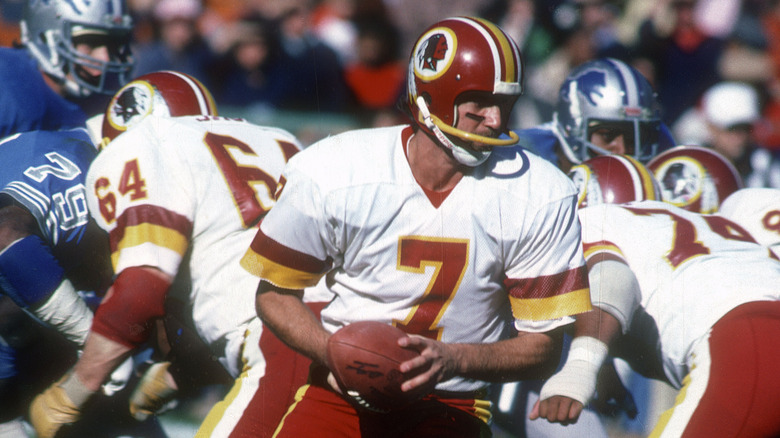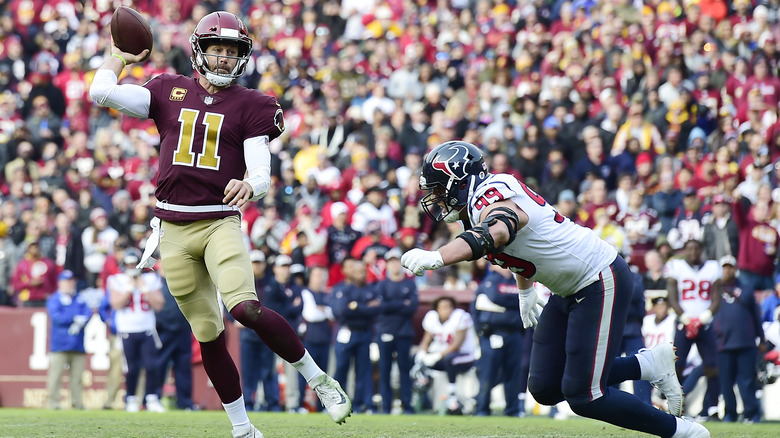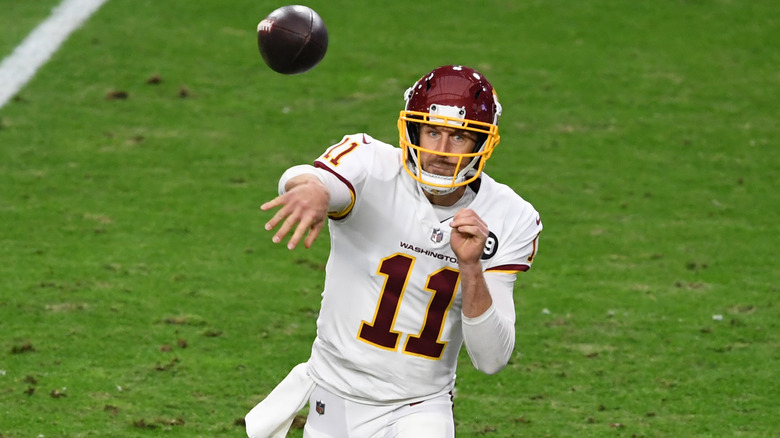The Similarities Between Alex Smith And Joe Theismann's Gruesome Injuries Are Like A Twilight Zone Episode
If one were to simply look at their career resumes and statistics, Joe Theismann and Alex Smith are as disparate as you can get as then-Washington Redskins quarterbacks. For starters, Theismann played his entire career in Washington, suiting up for the team now known as the Commanders from 1974 to 1985, mostly in a first-string role. Smith, meanwhile, only joined the Redskins at the tail-end of his career, having previously played for the San Francisco 49ers and Kansas City Chiefs. Theismann, who nearly won the Heisman Trophy while playing for Notre Dame ("Theismann wins Heisman" would have been quite the headline), was a mere fourth-round pick in 1971; Utah product Smith was the first overall selection of the 2005 NFL Draft. Theismann was a star of the boomer generation, while Smith represented the millennial generation of quarterbacks. You get the idea.
Then again, the two signal-callers have some similarities worth mentioning. Theismann and Smith both took a while to catch on; the former spent his first pro years in Canada and later warmed the bench behind veteran Billy Kilmer in Washington before becoming a full-time starter at age 29, the latter had the makings of a draft bust before he broke out with the Chiefs in 2011, his age-27 season. Both were selected to multiple Pro Bowls, and both became football analysts after retiring from the field. But the biggest set of similarities between Smith and Theismann can be found in the devastating late-career injuries they suffered. As you'll find out in a bit, the parallels between both injuries are so many that you'd probably swear you were in the middle of an episode of "Black Mirror" or "The Twilight Zone."
A plethora of similarities beyond the type of injury
Stay with us here — this all happened in real life, and there were so many similar or outright identical elements at play, as enumerated by the NFL Memes Twitter account shortly after ESPN aired the Alex Smith documentary, Project 11, on May 1, 2020. Let's start with the type of injury and the date when it occurred. Joe Theismann broke his right tibia and fibula on November 18, 1985, and Smith broke the very same bones exactly 33 years later, on November 18, 2018. The injuries both took place during a Washington Redskins home game. Feeling creeped out yet? We're just getting started.
When it came to the defensive stars involved in the unfortunate plays, there were two three-time Defensive Player of the Year winners mentioned — Lawrence Taylor for Theismann's injury, and J.J. Watt for Smith's. And it can be argued that the injuries could have been avoided if both QBs had better protection from their offensive line; the '85 Redskins were missing Joe Jacoby when Theismann got hurt, and the '18 Redskins had Trent Williams sitting out. Jacoby and Williams both played left tackle and were Pro Bowlers at that position. And to top it all off, the final score in both games was 23-21.
Yes, that's a ton of mind-blowing coincidences, but is it possible that the NFL Memes post tried to further the eerie narrative by fudging some details?
The parallels aren't as many as they were cracked up to be
According to Odd Sports Stories, most of the coincidences listed in the NFL Memes Twitter post check out, though there are some in which creative liberties, if you can call them that, were taken. The Twitter post claims Alex Smith and Joe Theismann both went down on the 39-yard line, but the publication clarified that based on film of the game where Theismann got hurt (play-by-play data is only available from 1994 onward), the signal-caller was sacked on Washington's 41. Smith was dropped on the Houston Texans' 37, per the NFL's official play-by-play logs. That's still pretty close in the grand scheme of things, but not at the exact same spot.
A lot of truths were also seemingly stretched in NFL Memes' line about the players who supposedly sacked Theismann and Smith. It's correct that both Lawrence Taylor and J.J. Watt won three Defensive Player of the Year awards, but the New York Giants linebacker was a two-time winner at the time he effectively ended Theismann's career with a sack; he only became a three-time DPOY the next season. Thirty-three years later, it was Kareem Jackson, not Watt, who was credited for the sack when Smith got injured, as Watt was late on the tackle and therefore did not receive any credit.
Furthermore, there are subtle differences in terms of the stadiums at which the games were played; the Theismann injury game was held at the Robert F. Kennedy Memorial Stadium, while the Smith game took place at FedEx Field, which had replaced the RFK Stadium as the Redskins' home. And while the Redskins beat the Giants in the former contest, the latter game ended in favor of Houston. As such, the "23-21" coincidence is also legit, but it doesn't tell the whole story.
Theismann's career was over, but Smith played one more year
Though it's not listed by NFL Memes on Twitter, given that the post was shared in May 2020, there is one final difference between Joe Theismann's and Alex Smith's injuries. After that fateful game against the New York Giants in 1985, Theismann never played another down of professional football. Smith, on the other hand, went on to play one more season, and it's mighty impressive that he did. Per The Ringer, Smith additionally suffered from necrotizing fasciitis and sepsis after the wounds caused by his injury got infected. His condition got so serious that his right leg was nearly amputated, but after 17 surgeries and an extensive period of rehab, he was back on the field for the Washington Football Team (as they were temporarily known after they dropped the Redskins moniker) in 2020.
Smith's numbers in his final NFL season were anything but impressive as he was part of a fluid quarterback rotation that included three other men — Kyle Allen, Taylor Heinicke, and the late Dwayne Haskins. But Washington earned a wild card spot despite their losing regular-season record, and Smith, who announced his retirement in April 2021, was an easy — and very deserving — choice for the NFL's 2020 Comeback Player of the Year award.



